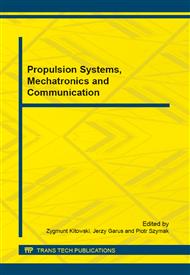[1]
Borenstein J., Koren Y., The Vector Field Histogram – Fast Obstacle Avoidance For Mobile Robots, IEEE Journal of Robotics and Automation Vol. 7, No 3, str. 278-288, (1991).
DOI: 10.1109/70.88137
Google Scholar
[2]
Minquez J., Montano L., Nearness Diagram Navigation (ND): A New Real Time Collision Avoidance Approach, Proceedings of the IEE/RSJ International Conference on Intelligent Robots and Systems, Japan 2000, pp.2094-2100.
DOI: 10.1109/iros.2000.895280
Google Scholar
[3]
Minquez J., Montano L., Nearness Diagram (ND) Navigation: Collision Avoidance in Troublesome Scenerios, IEEE Transaction on Robotics and Automation, Vol. 20 No. 1, 2004, pp.45-59.
DOI: 10.1109/tra.2003.820849
Google Scholar
[4]
Siegwart R., Nourbakhsh I. R., Introduction to Autonomous Mobile Robots. Cambridge Mass., England, MIT Press, (2004).
Google Scholar
[5]
Teledyne BlueView, Inc. internet site: http: /www. blueview. com, access: 30. 04. (2015).
Google Scholar
[6]
Ulrich I., Borenstein J., VFH*: Local Obstacle Avoidance with Look-Aheead Veriication, Proceedings of the IEEE International Conference on Robotics and Automation, str. 2505-2511, San Francisco, CA, (2000).
DOI: 10.1109/robot.2000.846405
Google Scholar
[7]
Xu H. L., Feng X. S., An AUV Fuzzy Obstacle Avoidance Method Under Event Feedback Supervision, Proceedings of IEEE OCEANS 2009 Conference, Vol. 1-3, str. 808-813, Biloxi MS USA, (2009).
DOI: 10.23919/oceans.2009.5422363
Google Scholar
[8]
Zak A., Choosen Problems of Control Team of Autonomous Underwater Vehicles [in Polish], Scientific Papers of PNA no 192A, Gdynia (2013).
Google Scholar
[9]
Żak A., Modeling of underwater vehicle's dynamics, System Theory and Applications Vol. 2, Greece 2007, pp.44-49.
Google Scholar
[10]
Zak B., Safe Control of Unmanned Underwater Vehicle Near to the Sea Bottom, Polish Journal of Environmental Studies, vol. 17, no 3C, 2008, pp.119-123.
Google Scholar
[11]
Zak B., The Minimal-Time Control in Collision Situation on The Sea, WSEAS Transactions on Systems, Issue 11, Vol. 5, November 2006, pp.2489-2494.
Google Scholar
[12]
Zak B., About Certain Method of Control of Unmanned Underwater Vehicle During Search of Objects Near to the Bottom Sea, WSEAS Transactions on Systems, Issue 6, Vol. 4, 2005, pp.751-760.
Google Scholar


